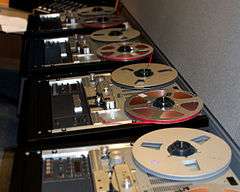British Library Sound Archive
 The Archive became part of the British Library in 1983. | |
| Country | United Kingdom |
|---|---|
| Location | 96, Euston Road, London, England, NW1 2DB |
| Collection | |
| Size | 6,500,000 recordings |
| Website | sounds.bl.uk |
The British Library Sound Archive (formerly the British Institute of Recorded Sound; also known as the National Sound Archive (NSA)[1]) in London, England is among the largest collections of recorded sound in the world, including music, spoken word and ambient recordings.
It holds more than six million recordings,[2] including over a million discs and 200,000 tapes. These include commercial record releases, chiefly from the UK, but with some from overseas, radio broadcasts (many from the BBC Sound Archive) and privately made recordings.
History

The history of the Sound Archive can be traced back to 1905, when it was first suggested that the British Museum should have a collection of audio recordings of poets and statesmen. The Gramophone Company started donating metal masters of audio recordings in 1906 (on the basis that records would wear out), with a number of donations being made up until 1933. These recordings included some by Nellie Melba, Adelina Patti, Caruso and Francesco Tamagno, and others of Lev Tolstoy, Ernest Shackleton, Herbert Beerbohm Tree and Lewis Waller. A number of shellac pressings were also donated in the period 1920-50.[3]
In 1955, Patrick Saul founded the British Institute of Recorded Sound, after realising that material was in danger of being lost as the British Museum did not maintain a comprehensive archive. The Institute was located in a property owned by the British Museum in Russell Square (with rent and rates guaranteed by Robert Mayer), and supported by a donation from the Quaker trust in Birmingham. A public appeal resulted in the donation of thousands of shellac discs, which started off the collection.[3]
The British Institute of Recorded Sound became part of the British Library, which had been split off from the British Museum, in April 1983.[3] It was later renamed the British Library Sound Archive. The metal masters originally collected by the British Museum were transferred to the Archive in 1992.[4]
Collections
The specialist collections are:[5]
- Classical music
- Drama and literature
- Oral history
- Moving images
- Popular music[5] and jazz[6]
- Radio recordings[5]
- Spoken language and dialects[7]
- Wildlife and other nature sounds
- World and traditional music
Printed materials
The Sound Archive holds an extensive reference collection of printed materials relating to recordings. The collection includes books and periodicals from around the world, a wide-ranging collection of discographies, and one of the largest collections of commercial record catalogues dating back to the early 1900s.
Historic playback equipment
A reference collection of playback and recording devices, including historic gramophones and record players, that chart the history of sound reproduction equipment. Photographs of some of these may be viewed online.[8] In addition, the Sound Archive's engineering department maintains a wide selection of working playback tape and disc players for the purposes of digitising its sound collections.
Services
The Sound Archive provides a range of services. The Sound Archive's online catalogue of over 1.5 million recordings can be viewed at http://cadensa.bl.uk, and it is updated daily. Recordings may be listened to free of charge in the British Library Reading Rooms. Copies of recordings can be purchased subject to copyright clearance and spectrograms of wildlife sounds can be made to order. The British Library Sounds service provides free online access for UK higher and further education institutions to over 60,000 rare recordings of music, spoken word, and human and natural environments. 65% of these recordings are also freely accessible for public listening online.
Educational services
The British Library offers training workshops and events in oral history and wildlife sound recording, as well as audiovisual archiving internships.
Publications
Playback, the bulletin of the British Library Sound Archive, was published free of charge from 1992 to 2010. All 44 issues are available online. A range of British Library CDs are available covering nature sounds, world music, historical speeches and recordings of famous poets, playwrights and authors.
See also
- Theatre Archive Project Oral History strand.
- British Library Sounds free online access to over 60,000 sound tracks.
- Peter Copeland Conservation Manager of the National Sound Archive/British Library Sound Archive from 1986 to 2002.
- National Life Stories, an independent charitable trust within the Oral History section of the British Library.
References
- ↑ "National Sound Archive". In L. Root, Deane. Grove Music Online. Oxford Music Online. Oxford University Press. (subscription required)
- ↑ "Save our Sounds". British Library. Retrieved 6 April 2015.
- 1 2 3 Day, T. (2001). The National Sound Archive: the first fifty years. pp 41-64 in Aural History: Essays on Recorded Sound (A. Linehan, Ed.). The British Library. ISBN 0-7123-4741-0
- ↑ "British Museum Gramophone recordings". British Library.
- 1 2 3 "About the British Library Sound Archive". British Library. Archived from the original on 7 February 2010. Retrieved 14 January 2011.
- ↑ "Radio recordings: jazz and popular music". British Library. Retrieved 29 July 2013.
- ↑ "Sound". British Library. Retrieved 29 July 2013.
- ↑ "Playback & recording equipment". British Library. Retrieved 6 April 2015.
External links
- British Library Sound Archive web pages
- British Library Sound Archive on Twitter

- The British Library Sound and Moving Image catalogue (SAMI)
- British Library Sounds
- Playback: the bulletin of the British Library Sound Archive
- Online gallery: record players 360° rotatable views of 13 machines
Coordinates: 51°31′47″N 0°07′39″W / 51.5298°N 0.1275°W
